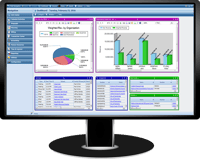Full Sail Partners is Honored to Receive a 2018 Premier Award for Client Satisfaction from PSMJ Resources and Client Savvy
 Full Sail Partners, a Deltek Platinum Partner, is pleased to announce that it has been selected as a recipient of the 2018 Premier Award for Client Satisfaction by PSMJ Resources and Client Savvy, creator of the Client Feedback Tool. This recognition only goes to firms involved in the AEC industry who have gone above and beyond to deliver a truly exceptional client experience.
Full Sail Partners, a Deltek Platinum Partner, is pleased to announce that it has been selected as a recipient of the 2018 Premier Award for Client Satisfaction by PSMJ Resources and Client Savvy, creator of the Client Feedback Tool. This recognition only goes to firms involved in the AEC industry who have gone above and beyond to deliver a truly exceptional client experience.
The success of professional service firms depends on creating strong client relationships, specifically through the service delivery of a project. Full Sail Partners recognized this need not only for its own firm, but for others in the industry. In order to gain consistent feedback on their projects, Full Sail Partners identified a need to streamline and automate the process for Project Managers. This endeavor resulted in creating their first Blackbox Connector to share data between Deltek Vision and the Client Feedback Tool.
“Among other aspects of our CX strategy, Full Sail Partners has found great success in consistently using the Client Feedback Tool to gauge client insight and make appropriate changes to improve the client experiences,” stated Sarah Gonnella, VP of Marketing and Sales. “We are greatly honored to be recognized with this Premier Award for Client Satisfaction.”
For more than 40 years, PSMJ Resources, Inc. has been recognized as the leading publishing, executive education, and advisory group devoted completely to improving the business performance of A/E/C organizations worldwide.
Recipients of the Premier Award for Client Satisfaction are determined using data collected from 280,000 surveys across 300 firms. Based upon the surveys, firms which really stand out regarding client feedback are given this prestigious designation. The 2018 award winners will be recognized at the October THRIVE conference put on by PSMJ in San Diego.
“Full Sail Partners sets themselves apart from competition through creating great experiences and outcomes for their clients,” stated PSMJ Resources Founder and CEO Frank A. Stasiowski, FAIA. “As we hear more and more frustration from architects and engineers about downward pressure on fees, delivering a best-in-class client experience is one of the best ways to differentiate your firm.”
Client Savvy works with professional services organizations whose success depends on strong client relationships. Their commitment to clients is to help them align their client experience (CX) strategy, implementation, and measurement initiatives with their top strategic priorities.
“Firms committed to delivering great client experiences are twice as likely to be recommended by their clients, three times as likely to realize above-average financial returns, and consistently attract and retain better employees. Full Sail Partners commitment to listen and act is a foundational component of every great client experience strategy.”
For more information, please contact Full Sail Partners’ Marketing and Communications Department.






 Full Sail Partners is dedicated to helping businesses be the best they can be. Therefore, we consistently provide a variety of resources offering much insight to our clients. These can be found on the resources tab of our website. From webinars and webcasts to whitepapers and events, we want to ensure our clients run at maximum efficiency. Let’s check these resources out.
Full Sail Partners is dedicated to helping businesses be the best they can be. Therefore, we consistently provide a variety of resources offering much insight to our clients. These can be found on the resources tab of our website. From webinars and webcasts to whitepapers and events, we want to ensure our clients run at maximum efficiency. Let’s check these resources out.
 The goal of an Enterprise Resource Planning (ERP) system is to integrate all aspects of a business from finance to CRM to HR. To have and maintain a successful business operation, accurate and timely information must flow between all the different business functions. With an ERP in place, there is visibility into operations which provides greater control over the business. However, while all businesses benefit from an ERP system, one size does not fit all. Project-based companies are distinct and thus require ERPs suited for their needs.
The goal of an Enterprise Resource Planning (ERP) system is to integrate all aspects of a business from finance to CRM to HR. To have and maintain a successful business operation, accurate and timely information must flow between all the different business functions. With an ERP in place, there is visibility into operations which provides greater control over the business. However, while all businesses benefit from an ERP system, one size does not fit all. Project-based companies are distinct and thus require ERPs suited for their needs. It used to be that people needed companies - employees were loyal, jobs were scarce, and everyone accepted the standard employment package offered. Today, things are very different. Companies need people – talent is hard to find, few make long term commitments, and many are demanding a lot more than before. Project-based companies are particularly impacted since without the right people in place, projects suffer, customers suffer and so does the bottom line. Therefore, having an applicant tracking system is a necessity to deal with the challenges of talent acquisition.
It used to be that people needed companies - employees were loyal, jobs were scarce, and everyone accepted the standard employment package offered. Today, things are very different. Companies need people – talent is hard to find, few make long term commitments, and many are demanding a lot more than before. Project-based companies are particularly impacted since without the right people in place, projects suffer, customers suffer and so does the bottom line. Therefore, having an applicant tracking system is a necessity to deal with the challenges of talent acquisition.
 Expense management seems to be a difficult task for accounting personnel at many professional services firms. With a workforce that is constantly on the go, tracking spending and enforcing expense policies can provide a plethora of challenges. What if there was a better way to manage expenses? Let’s see what firms can do to improve the expense management process.
Expense management seems to be a difficult task for accounting personnel at many professional services firms. With a workforce that is constantly on the go, tracking spending and enforcing expense policies can provide a plethora of challenges. What if there was a better way to manage expenses? Let’s see what firms can do to improve the expense management process.


 You’ve probably heard the saying, “bad data in – bad data out.” Well, bad data is outdated, incorrect, incomplete or duplicated information, and according to the Harvard Business Review, workers waste 50% of their time dealing with it. Now ask yourself, when was the last time someone at your firm took a deep dive into the data in your enterprise resource planning (ERP) system? While the process of cleaning company data is time consuming, it is something all firms should do on regular basis. Businesses can achieve numerous benefits by fixing bad data. Here’s a look at some of the top benefits.
You’ve probably heard the saying, “bad data in – bad data out.” Well, bad data is outdated, incorrect, incomplete or duplicated information, and according to the Harvard Business Review, workers waste 50% of their time dealing with it. Now ask yourself, when was the last time someone at your firm took a deep dive into the data in your enterprise resource planning (ERP) system? While the process of cleaning company data is time consuming, it is something all firms should do on regular basis. Businesses can achieve numerous benefits by fixing bad data. Here’s a look at some of the top benefits.

